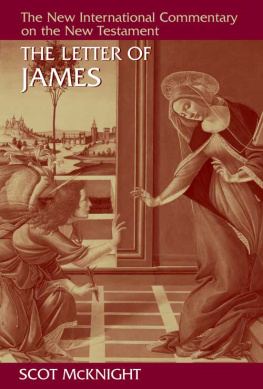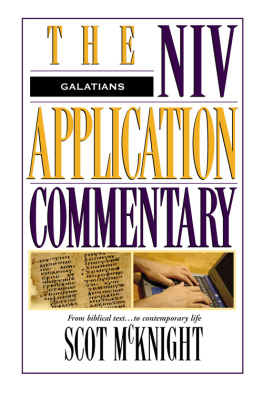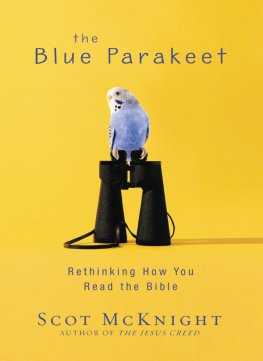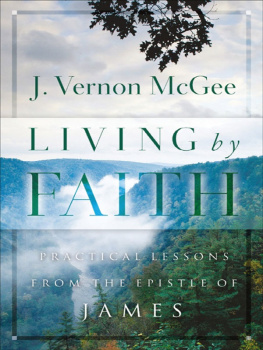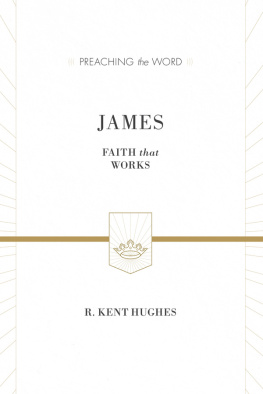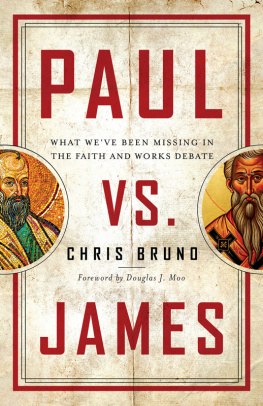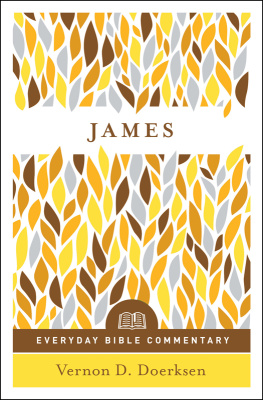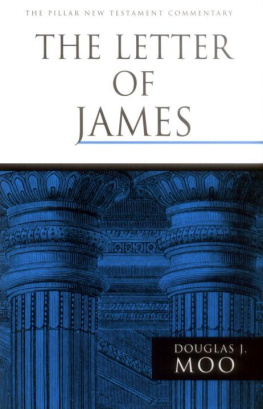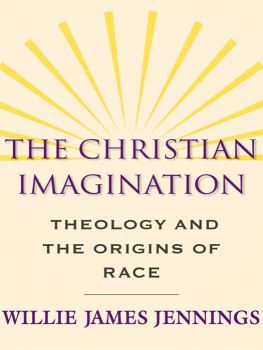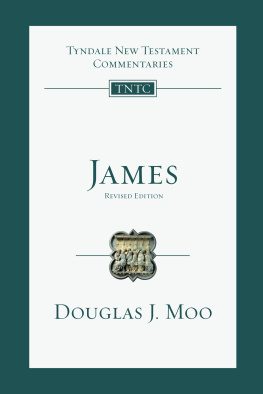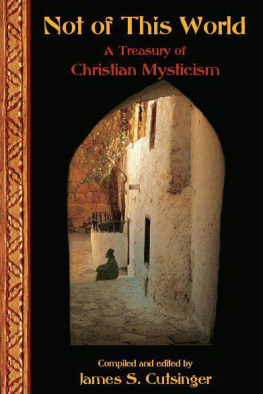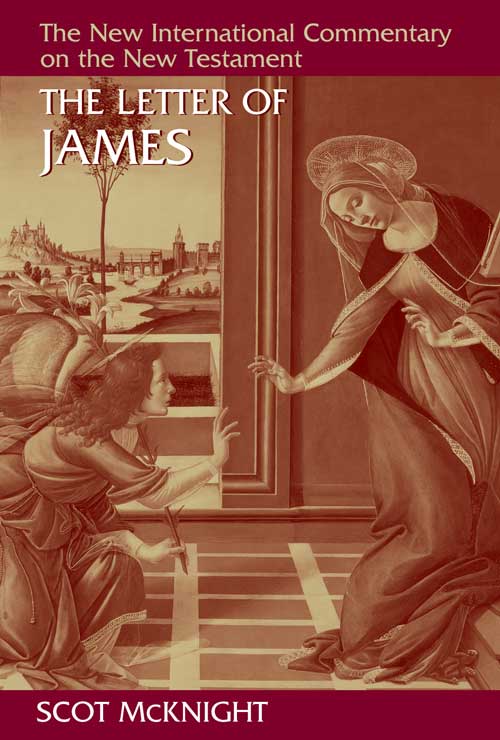
The Letter of
JAMES
SCOT McKNIGHT
W ILLIAM B . E ERDMANS P UBLISHING C OMPANY
G RAND R APIDS, M ICHIGAN/ C AMBRIDGE, U . K .
2011 Scot McKnight
All rights reserved
Wm. B. Eerdmans Publishing Co.
2140 Oak Industrial Drive N.E., Grand Rapids, Michigan 49505 /
P.O. Box 163, Cambridge CB3 9PU U.K.
www.eerdmans.com
Library of Congress Cataloging-in-Publication Data
McKnight, Scot.
The letter of James / Scot McKnight.
p. cm.(The new international commentary on the New Testament)
Includes .
eISBN 978-1-4674-2391-5
ISBN 978-0-8028-2627-5 (alk. paper)
1. Bible. N.T. JamesCommentaries. I. Title.
BS2785.53.M37 2011
227.91077dc22
2010040751
Unless otherwise noted, the Scripture quotations in this publication are from the New Revised Standard Version Bible, copyright 1989 by the Division of Christian Education of the National Council of Churches of Christ in the U.S.A., and used by permission.
For
Aksel
Grant, O God, that, following the example of your servant James, the brother of our Lord, your Church may give itself continually to prayer and to the reconciliation of all who are at variance and enmity; through Jesus Christ our Lord, who lives and reigns with you and the Holy Spirit, one God, now and for ever. Amen.
The Book of Common Prayer
For the LORD your God is God of gods and Lord of lords, the great God, mighty and awesome, who is not partial and takes no bribe, who executes justice for the orphan and the widow, and who loves the strangers, providing them food and clothing.
Deuteronomy 10:1718
A disciple is not above the teacher, but everyone who is fully qualified will be like the teacher.
Luke 6:40
At the Council of Jerusalem, the Jewish Christians asked themselves whether Christians from among the Gentiles could be saved if they were not willing to be circumcised and to observe the Mosaic law. A century later, it was the pagan Christians who were asking themselves whether a Christian who observed the law of Moses could obtain his salvation.
Pierre-Antoine Bernheim, James, the Brother of Jesus
Der Jakobus brief ist rehabilitiert.
Walther Bindemann, Weisheit versus Weisheit
The critical question is not the one we put to the text but the one that the text puts to us.
Luke Timothy Johnson, Reading Wisdom Wisely
CONTENTS
INDEXES
It has now been thirty-five years since the original commentary on the Epistle of James, written by James Adamson, appeared in this series (in 1976). Since the publication of that commentary, which served its generation well, there has been a considerable proliferation of interest and scholarly literature on this Epistlelong overdue in Protestant circles who had labored far too long under Luthers damning pronouncement that it was a right strawy epistle. The present commentary has been written by one who has played a significant role in bringing about this much-needed corrective.
At the turn of the present century a replacement commentary on this Epistle had been assigned to Donald J. Verseput of Bethel Seminary. But his untimely death in 2004 at the age of 51 also brought momentary `closure to that chapter for this commentary series. So it was a moment of considerable delight when a couple of years later Scot McKnight consented to pick up this task. Those who use/read this commentary will quickly recognize what a fortunate decision that has turned out to be.
Here is a commentary that is accessible to a broad readership, at once full of insight and of (that all-too-often missing) good sense and wit in commentary writing that make for both good reading and an especially helpful source for consultation as to what James is about. I therefore take special pleasure in introducing it to the larger community of pastors and scholars, who will find much help here.
G ORDON D . F EE
I first began teaching James in the mid 1980s. My classes were mostly seminary students and we dug into the Greek text and read the standard commentaries. This commentary began in and reflects that setting. Along with digging into the Greek text, I cut my teeth by reading a few commentaries, including those by F. J. A. Hort, J. B. Mayor, M. Dibelius, C. L. Mitton, P. Davids, S. Laws, R. P. Martin, and the predecessor in this series, J. B. Adamson, and Adamsons lengthy volume on the theology of James. At that time my colleague Doug Moo was writing a small commentary on James and we had many conversations in passing about James. I cannot forget the original flush of discoveries I had with my students and the above-mentioned commentaries. A bonus for me has been that Doug Moo wrote a second commentary on James and part of the final preparation of this commentary was reading his second work. I consider it a privilege to have been his student and colleague, and even more to be a friend. A former colleague at North Park University, a classicist, David Nystrom, also wrote a commentary on James, and I recall a number of conversations with him about James as he was writing what I think is the most useful commentary on James for preachers. His facility in the ancient sources of Rome and Greece gives his commentary a special edge.
But this is not a commentary on commentaries or the ins and outs of scholarly suggestions on every point that can be raised about this most vexing of early Christian letters. In fact, every time I left a passage to begin a new one I sensed I had ignored scholars who deserved more interaction, and I apologize now to those I have neglected and to those from whom I have learned and whose names might not appear in the footnotes. Hence, this commentary will be my own interaction with the text of James. It is shaped from beginning to end for pastors, preachers, and teachersin other words, it is an ecclesial commentary that attempts to expound the meaning of the text. I hope it is as much sapientia as it is scientia , wisdom as science. I do not have a pet theory about James to argue. Some find the theme of wisdom in every verse while others find poverty everywhere and yet others find ideological rhetoric everywhere. I have learned from such technical studies, but my interests are less on shedding fresh light and more on providing for preachers and teachers a commentary shaped for those who want to explain James and his significance to congregations and classes.
Throughout this commentary I have compared the . My use of it in this commentary will now serve as a memorial to a useful translation.
When I was a professor at Trinity Evangelical Divinity School, my graduate assistant, John Raymond, amassed an excellent bibliography on James that has stood the test of time for me. Chris Ridgeway, my assistant now at North Park University, has generously done bibliographic tasks that, had they been left to me, would certainly delayed the completion of this commentary, and I am grateful for his assistance. Elaine Halama at North Park Universitys Brandel Library deserves thanksgiving beyond words for her uncommon diligence and skill. Several of my former students, now professors themselves, have read portions or all of this manuscript and I wish here to express my appreciation to them: Sam Lamerson, Doug Huffman, Matt Williams, Jon Lunde, and Steve Bryan. My colleague Joel Willitts and I have enjoyed more than a few discussions of James.
I am grateful to the Eerdmans family, not the least of my reasons being that as a college student I hung out at The Bookstore, became friends with Casey Lambregste, and dreamed that someday I would write a commentary in this series. I express my gratitude to Bill and Anita Eerdmans and to Sam, whom I met when he was a high-schooler and tending The Bookstore. For years I have had conversations about the Cubs with Reinder Van Til and Jann Myers. Gordon Fee invited me to write James after I finked out on Matthew, and I thank him for his grace. I also want to thank John Simpson for his patience and care in editing and Drew Strait for his help with the indexes.
Next page
